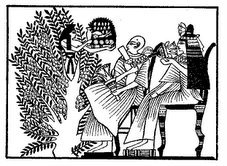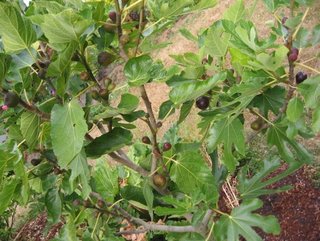
Over the past few winters, these geraniums were brought into the garage in the early Winter, left until Spring, then carried outside again. The garage doesn't freeze. Advance preparation amounted to moving them into a rain-free location outdoors for about one month prior to being brought indoors. By drying out in the cool weather, dormancy was induced, and they did not grow tall and leggy in the dark.
Each year they grow larger, with more leaves and flowers. In the past, I did not like the scent of the geranium leaves, but now I like to rub them between my fingers & inhale the scent. They are earthy and spicy at the same time.
Around the yard, there are quite a few plants that have survived and grown, for up to five Summers now, including some additional geraniums, Fuchsias, and several fig trees (which might have survived outside). A heliotrope that I did not intend to keep survived by the same method, simply because the container was moved into the garage while cleaning the yard. The peppers that I did this with did not survive.
Another plant which survived the past 2 winters, with almost no effort, is a "night blooming cereus" -
Epiphyllum oxypetalum grown from a cutting from a coworker, that sits in a window without water for the winter, and brought outside in the summer. This plant has a half-dozen buds on it now, so it will probably bloom in a few weeks.
Since these plants are in containers, overwintering did not even involve digging them up. Keeping them from one year to the next is actually less effort than buying new ones in the Spring - which would involve shopping, driving (OK, a multipurpose trip to a discount store would not involve additional driving, but the point is still valid), spending money, and usually buying small plants that take a couple of months to reach full size. Discarding them involves putting them into a waste container to be hauled away. It is less effort to keep them for the following year.
In addition, these geraniums provided cuttings that yielded additional plants with virtually no effort - a little pruning, remove the lower leaves from the trimmings, and put into the soil in a sheltered spot; most took root and grew without any separate watering, potting, or other interventions.
So, by doing almost nothing - just some puttering - these plants survive the winter and become bigger each year.

 As long as we are on the topic of growing fruit in ancient Egypt, we can add some interesting information about grapes. According to this website, Grapes were grown as a stone age crop in Europe, and the ancient Egyptians grew grapes for wine. Certainly, grapes are a biblical crop.
As long as we are on the topic of growing fruit in ancient Egypt, we can add some interesting information about grapes. According to this website, Grapes were grown as a stone age crop in Europe, and the ancient Egyptians grew grapes for wine. Certainly, grapes are a biblical crop.














 Sweet Baby Girl
Sweet Baby Girl